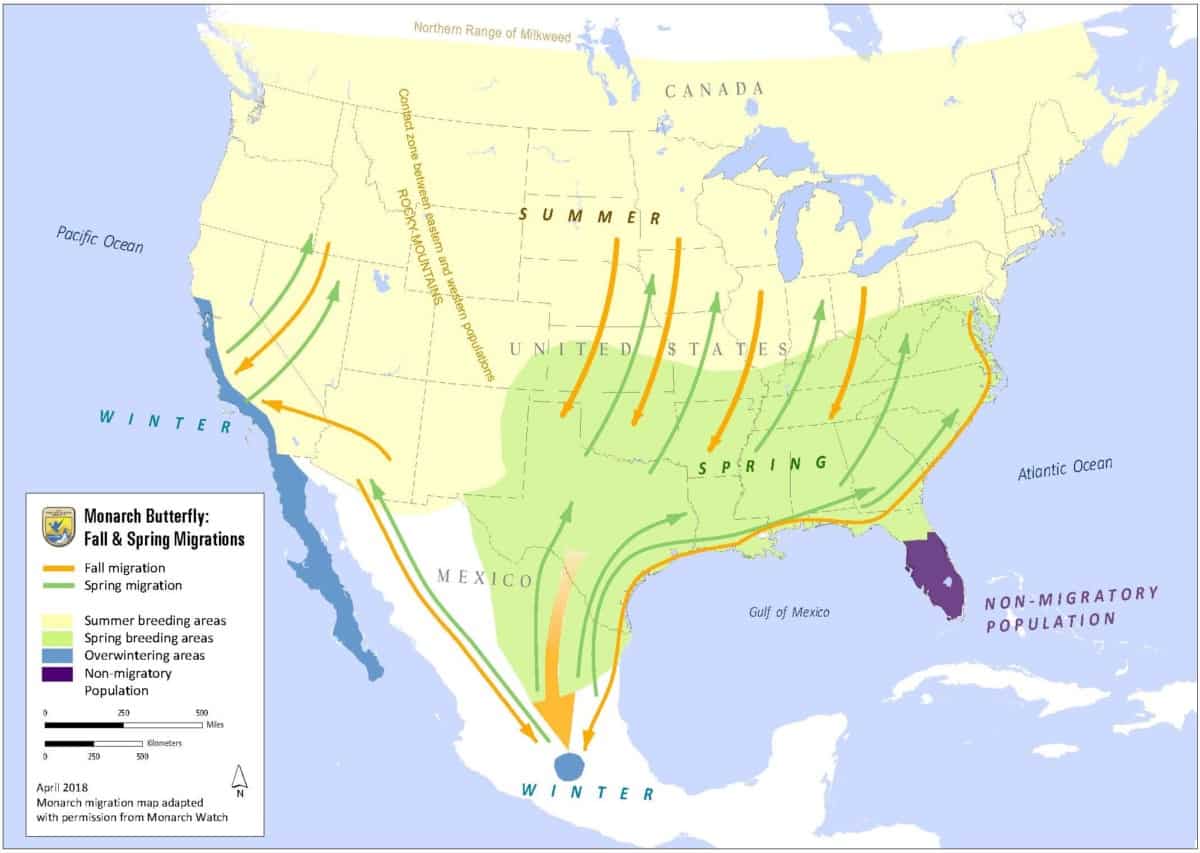A few years ago I started a memorial butterfly garden for a son we lost during pregnancy. As I started to research butterfly gardens, I kept coming across articles about the drastic decline of the Monarchs that migrated to Mexico for the winter. The more I researched and the more I read about Monarchs, a lot of the articles talked about the Mexico migration. I eventually started to wonder if all Monarchs migrated to Mexico.
The answer is no, not all Monarchs migrate to Mexico for the winter. Monarchs live on several continents around the world, but only the Monarchs that live in the continental United States and Canada make the journey to Mexico for the winter. Actually, that statement is only 99% true. Not all Monarchs in the US and Canada migrate to Mexico. Most of them do, but not all of them.
If you read my Where Do Monarch Butterflies Live article, you know that Monarchs don’t just live in North America. It has been discovered that the Monarch originated in North America, but over time they’ve managed to find their way to other continents. In this post, you will learn which Monarchs head to Mexico for the winter, which ones migrate to other places, and which ones don’t migrate at all.
North America
In North America, Monarch butterflies can be found throughout the United States, southern Canada, and Mexico. There are actually 2 separate populations of Monarchs in North America. The Monarchs that live to east of the Rocky Mountains are the eastern population and those living to the west of the Rockies are considered the western population. Ninety-Nine percent (99%) of the Monarchs in North America are in the eastern population. It is this population that starts the journey to Mexico every fall and returns in the spring. Depending on where they are, this journey can be up to 3,000 miles. I need to be a bit cautious and say that most of the eastern population migrates to Mexico. There is a small number of Monarchs along the east coast that detour to southern Florida and don’t continue on to Mexico. They’ve also found an overwintering site along the Salt River in Phoenix, Arizona.
The Monarchs that do go to Mexico flock to the oyamel fir trees in the State of Mexico and Michoacan, both of which are in central Mexico. What’s interesting, and something that scientists have yet to figure out, is how the butterflies know to migrate there. The Monarchs that arrive in Mexico for the winter have never been there before. Their parents and grandparents haven’t been there either. You see, Monarchs go through several generations (up to 5) from the time they leave Mexico in the spring to the time they return in the fall. So it’s not like they were told where to go from their parents or grandparents. One of the theories that scientists have is that it is somehow ingrained in their DNA.
The western Monarch population only accounts for about 1% of the Monarchs in North America. They do not go to Mexico for the winter, but instead they spend the winter along the Pacific coast of central and southern California. And instead of roosting in oyamel trees like the eastern population in Mexico, the western population congregate on eucalyptus trees, Monterey pine trees, and Monterey cyprus trees.
The map below shows the migration patterns of the Monarch butterfly in North America.

Credit: USFWS Midwest Region
Central America
In Central America, Monarchs inhabit the countries of Belize, Costa Rica, El Salvador, Guatemala, Honduras, Nicaragua, and Panama. It was difficult to find information on if Monarchs in Central America migrated or not, but from what I did find, it appears that they do migrate, but nowhere near the 3,000 miles that the North American Monarchs do. In Central America, they only need to migrate up to 60 miles, and instead of migrating because of temperature, they migrate because of seasonal wet and dry conditions.
South America
In South America, there are actually two species of Monarchs. The danaus plexippus (the same species that is found in the US and Canada) can be found in far northern part of the continent: Columbia, Ecuador, Guyana, Peru, Suriname, and Venezuela. There is also a Southern Monarch (danaus erippus) that can be found in Argentina, Bolivia, Brazil, Chile, Paraguay, Peru, and Uruguay. Through DNA testing it was found that the North American Monarch and the Southern Monarch are almost identical, but the two species are incompatible.
Information is vague at best, but it is thought that the Southern Monarch migrates south in the fall, just like the North American Monarch does. This is a bit strange. The Monarchs in the US and Canada migrate south to Mexico because they can’t survive in the cold winter climates of the northern states and Canada. They head south to a warmer climate for the winter. For the Southern Monarch, the opposite is true. By flying south for the winter, they are actually heading to a colder climate for the winter. Unlike the forests in central Mexico where hundreds of thousands of North American Monarchs can be found overwintering, to my knowledge, they have never found an overwintering site in South America.
Australia
The Monarchs in Australia are the same species that inhabit North America (danaus plexippus), but here they are called the Wanderer Butterfly, because it somehow managed to “wander” all the way from the United States. It is unknown if the Monarch flew to Australia on its own, or if it hitched a ride a ship.
It can be found mainly in the eastern and southern parts of the continent: New South Wales, Queensland, South Australia, and Victoria. It has also been seen in the Norther Territory, but only in isolated areas. The Monarchs, I mean the Wanderers, that are further inland during the summer months migrate to areas on the Australian coasts as winter approaches. Winter in Australia is from June 1st to August 31st, and summer is December 1st to the end of February, which is just the opposite of North America.
Pacific Islands
There are an estimated 25,000 islands in the Pacific Ocean and the islands are divided into 3 main groups: Melanesia, Micronesia, and Polynesia.
In Melanesia, the Monarch can be found on Fiji, New Caledonia, Papua New Guinea, and the Solomon Islands. It can be found on the the Caroline Islands, the Gilbert Islands, the Mariana Islands, and the Marshall Islands of Micronesia. And in Polynesia, the Monarch can be found on Cook Islands, French Polynesia, Hawaii, New Zealand, Norfolk Island, Samoa, Tonga, Tuvalu, and Wallis and Futuna.
Information on Monarch migration, and Monarch butterflies in general for those that inhabit the Pacific Islands is a little hard to come by. I did find that in New Zealand, there are overwintering sites in Auckland, Hastings, Napier, and Tauranga on the North Island; and Christchurch, Nelson, and Timaru on the South Island. I also found that Monarchs on Hawaii don’t appear to migrate. If I find information on Monarchs on the other Pacific Islands, I will update this article.
Africa
In Africa, North American Monarchs can be found on the coast of Morocco, the Canary Islands, and Madeira, and is non-migratory in these areas.
Europe
The Monarch has been found inhabiting England, Portugal, Scotland, Spain, Wales, and on the Azores Islands, but I was unable to find any information about their migration patterns, if any.
Conclusion
As you have learned, not all Monarchs migrate to Mexico for the winter. Most of those that inhabit the continental United States and Canada do overwinter in Mexico, but those that live on other continents do not. Depending on the climate in the region in which they live, the Monarch will either migrate, or it will be a year-round resident. While I tried to make this article as accurate and informational as possible, finding information on Monarchs outside the United States proved to be a bit difficult. This article will be updated if I find additional information.
